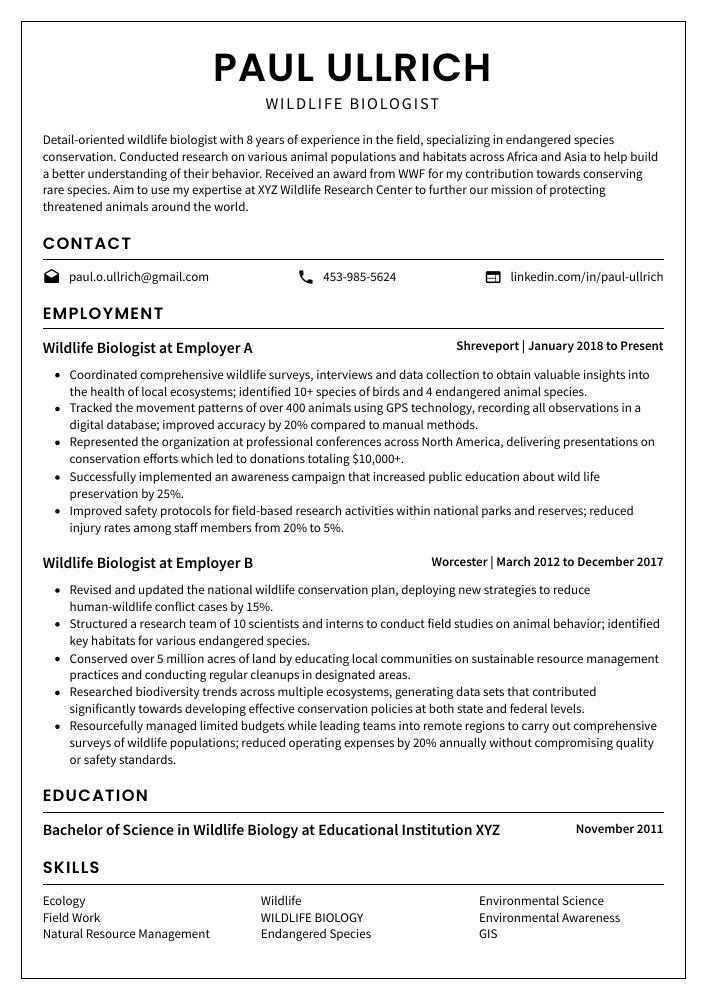Wildlife Biologist Resume Guide
Wildlife biologists study and observe animals in their natural habitats. They analyze the behavior, population dynamics, and health of various species by collecting data through research techniques such as field observations, surveys, experiments and monitoring programs. Wildlife biologists also work to develop strategies for conserving wildlife populations while minimizing conflicts between humans and wild animals.
You have a deep understanding of wildlife and their habitats, which could be an invaluable asset to any conservation organization. To make them aware of your credentials, you must craft a resume that stands out from the competition.
This guide will walk you through the entire process of creating a top-notch resume. We first show you a complete example and then break down what each resume section should look like.
Table of Contents
The guide is divided into sections for your convenience. You can read it from beginning to end or use the table of contents below to jump to a specific part.
Wildlife Biologist Resume Sample
Paul Ullrich
Wildlife Biologist
paul.o.ullrich@gmail.com
453-985-5624
linkedin.com/in/paul-ullrich
Summary
Detail-oriented wildlife biologist with 8 years of experience in the field, specializing in endangered species conservation. Conducted research on various animal populations and habitats across Africa and Asia to help build a better understanding of their behavior. Received an award from WWF for my contribution towards conserving rare species. Aim to use my expertise at XYZ Wildlife Research Center to further our mission of protecting threatened animals around the world.
Experience
Wildlife Biologist, Employer A
Shreveport, Jan 2018 – Present
- Coordinated comprehensive wildlife surveys, interviews and data collection to obtain valuable insights into the health of local ecosystems; identified 10+ species of birds and 4 endangered animal species.
- Tracked the movement patterns of over 400 animals using GPS technology, recording all observations in a digital database; improved accuracy by 20% compared to manual methods.
- Represented the organization at professional conferences across North America, delivering presentations on conservation efforts which led to donations totaling $10,000+.
- Successfully implemented an awareness campaign that increased public education about wild life preservation by 25%.
- Improved safety protocols for field-based research activities within national parks and reserves; reduced injury rates among staff members from 20% to 5%.
Wildlife Biologist, Employer B
Worcester, Mar 2012 – Dec 2017
- Revised and updated the national wildlife conservation plan, deploying new strategies to reduce human-wildlife conflict cases by 15%.
- Structured a research team of 10 scientists and interns to conduct field studies on animal behavior; identified key habitats for various endangered species.
- Conserved over 5 million acres of land by educating local communities on sustainable resource management practices and conducting regular cleanups in designated areas.
- Researched biodiversity trends across multiple ecosystems, generating data sets that contributed significantly towards developing effective conservation policies at both state and federal levels.
- Resourcefully managed limited budgets while leading teams into remote regions to carry out comprehensive surveys of wildlife populations; reduced operating expenses by 20% annually without compromising quality or safety standards.
Skills
- Ecology
- Wildlife
- Environmental Science
- Field Work
- Wildlife Biology
- Environmental Awareness
- Natural Resource Management
- Endangered Species
- GIS
Education
Bachelor of Science in Wildlife Biology
Educational Institution XYZ
Nov 2011
Certifications
Certified Wildlife Biologist
The Wildlife Society
May 2017
1. Summary / Objective
Your resume summary/objective is your chance to capture the attention of potential employers. You can use it to showcase your qualifications, experience, and passion for wildlife biology. For example, you could mention the field research projects you have worked on in different ecosystems around the world, any awards or honors you’ve received related to conservation efforts, and how your work has helped protect endangered species from extinction.
Below are some resume summary examples:
Talented and experienced wildlife biologist with a passion for conservation and research. Skilled in designing, executing, and analyzing field studies of animal behavior. At XYZ Company, conducted surveys to assess the impact of human activities on local ecosystems and developed successful strategies to mitigate negative impacts. Experienced in data analysis techniques using various software applications such as ArcGIS and R-Studio.
Well-rounded wildlife biologist with 8+ years of experience in field research, conservation planning and management. Passionate about the protection of wildlife species and ecosystems. At XYZ Research Institute, developed 10-year land stewardship plan for a protected area that increased biodiversity by 60%. Seeking to join ABC Nature Reserve to continue protecting endangered habitats through innovative environmental initiatives.
Reliable wildlife biologist with 8+ years of experience in research and conservation. Skilled at data collection, analysis, and reporting to inform management decision-making. As part of a team at XYZ Organization, identified new species’ habitats leading to successful protection initiatives that increased local biodiversity by 12%. Seeking an opportunity to use knowledge and skillset as the next Wildlife Biologist at ABC Firm.
Proficient wildlife biologist with five years of experience studying and analyzing wildlife habitats. Experienced in research, data collection and analysis, and report writing from field observations. Proven track record of developing successful conservation programs for state-protected species at XYZ Park. Skilled communicator able to communicate complex findings clearly to stakeholders, policy makers, and the public alike.
Hard-working wildlife biologist with 8+ years of experience researching, monitoring, and managing animal populations in various habitats. Proven success carrying out field studies to track animal behaviors, develop data collection techniques, and prepare reports on findings. Aiming to use expertise at ABC Company as a Senior Wildlife Biologist to protect endangered species and enhance their natural habitats.
Determined wildlife biologist with 8+ years of experience researching and studying wildlife populations in various habitats. Certified by the American Institute of Wildlife Management, eager to join ABC’s conservation efforts as a research specialist. Recent accomplishments include authoring two journal articles on endangered species preservation which garnered recognition from state officials.
Driven wildlife biologist with 5+ years of experience studying animal behavior and ecology. Seeking to join XYZ Research Institute as a wildlife biologist. At ABC, conducted field research on migratory bird populations that resulted in the discovery of previously unknown migration patterns. Received company award for my dedication and contribution to the organization’s mission.
Diligent wildlife biologist with 8+ years of experience researching and studying the ecology, behavior, and conservation of different species. Experienced in conducting field surveys to study habitats as well as analyzing data to produce detailed reports. Seeking opportunity at ABC Conservation Center to apply my expertise in protecting endangered species and their habitats.
2. Experience / Employment
In the experience section, you should provide details on your employment history. This section should be written in reverse chronological order, meaning the most recent job is listed first.
When stating what you did for each role, it’s best to stick to bullet points. Doing so makes it easier for the reader to take in all of the information quickly and accurately. When writing these bullets points, be sure to include detail about what you did and quantifiable results that were achieved due to your efforts.
For example, instead of saying “Conducted field research,” you could say “Collected data from wildlife habitats through direct observation; identified over 200 species during a three-month period.”
To write effective bullet points, begin with a strong verb or adverb. Industry specific verbs to use are:
- Monitored
- Collected
- Analyzed
- Researched
- Documented
- Presented
- Captured
- Tracked
- Examined
- Assessed
- Evaluated
- Identified
- Restored
- Protected
- Conserved
Other general verbs you can use are:
- Achieved
- Advised
- Compiled
- Coordinated
- Demonstrated
- Developed
- Expedited
- Facilitated
- Formulated
- Improved
- Introduced
- Mentored
- Optimized
- Participated
- Prepared
- Reduced
- Reorganized
- Represented
- Revised
- Spearheaded
- Streamlined
- Structured
- Utilized
Below are some example bullet points:
- Consistently conducted wildlife surveys, capturing and tagging over 500 animals per month in order to track population movements, behavior patterns and habitat usage.
- Prepared detailed reports on the environmental impacts of various human activities on endangered species; reduced incidences of illegal hunting by 40%.
- Examined animal specimens for signs of disease or infection; identified more than 10 new cases a week resulting in early treatment which improved overall survival rate by 15%.
- Identified potential threats to certain species such as climate change, deforestation and poaching that often led to proactive conservation measures being put into place ahead of time.
- Evaluated the effectiveness of existing conservation methods used throughout different regions with positive results seen within 4 months – increasing protected area coverage from 30% to 45%.
- Formulated and implemented wildlife management plans to protect endangered species, resulting in a 25% increase of the population over three years.
- Protected habitats by monitoring and tracking animal populations; identified potential risks from human activity and successfully lobbied for environmental legislation that resulted in $50,000 worth of funding towards conservation efforts.
- Developed new research methods to study large carnivores’ behaviors while living alongside local communities, gaining valuable insights into their ecology which was shared with other researchers worldwide via workshops and seminars.
- Advised government agencies on best practices related to habitat preservation and sustainable development; wrote a policy document which advocated for the protection of threatened species that earned recognition from international organizations such as UNEP & WWF.
- Meticulously analyzed data collected through field observations & surveys, leading to the publication of six peer-reviewed scientific papers over five years regarding conservation initiatives across different countries.
- Restored local wildlife population by 10% through successful implementation of conservation strategies and management plans.
- Utilized scientific methods to identify, monitor and study the behavior of various species in their natural habitats; conducted over 250 surveys for regional wildlife preservation efforts.
- Achieved a 90% success rate with animal relocations and rehabilitation programs based on data collected from field research projects completed in the last 24 months.
- Demonstrated expert knowledge when classifying plants & animals according to taxonomic nomenclature standards; identified rare species previously unknown to local authorities within 6 weeks of joining project team lead position.
- Reliably provided timely reports outlining findings, conclusions as well as potential risk factors that could influence habitat health or endanger individual creatures during monthly meetings with executive stakeholders at funding agency headquarters.
- Mentored a team of 4 junior wildlife biologists, overseeing their research and providing guidance on proper fieldwork techniques; improved data accuracy in the group by 28%.
- Substantially increased public awareness about endangered species through leading educational seminars at local schools and community centers for over 200 people.
- Facilitated the collection of over 5,000 samples from various ecosystems across 3 states to evaluate population levels, habitat changes and environmental impacts on wildlife habitats.
- Analyzed biological specimens using multiple microscopy techniques to identify advantages & disadvantages among different species; findings were published in 10+ scientific articles & journals worldwide.
- Compiled detailed reports analyzing trends found within collected sample data; presented results to state conservation committees that resulted in $25K worth of funding being allocated towards restoration efforts for affected areas.
- Thoroughly assessed local wildlife populations, conducted research and identified potential threats to species in a 1,000-acre area; increased understanding of the environment by 50%.
- Spearheaded conservation projects that helped restore habitats for over 20 threatened wildlife species; raised public awareness through education campaigns which resulted in more than $15K donations from private companies.
- Optimized monitoring protocols and implemented new procedures to track changes in animal behavior while reducing data collection time by 30 hours per week on average.
- Monitored weather conditions and water levels to identify suitable areas where endangered animals could be reintroduced into their natural habitat; successfully relocated 5% of target population back into safe environments within one year period.
- Coordinated with other biologists, researchers and environmentalists to develop strategies for protecting vulnerable ecosystems across the region; increase collaboration among teams led to tripling the success rate of preservation efforts within 6 months’ time frame.
- Participated in over 25 wildlife research projects, collecting and analyzing data on various species in their natural habitats to identify population trends and conservation needs.
- Introduced a new tracking system for endangered species that expedited the monitoring of animal migration patterns by 20%, leading to improved protection strategies.
- Competently handled field equipment such as binoculars, cameras, GPS units, measuring tools and computers during data collection sessions; accurately recorded observations regarding animal behavior and habitat conditions onsite each day.
- Expedited the process of tagging more than 200 birds with tracking devices in order to monitor migratory behaviors throughout an entire year-long study period; collected additional behavioral data through daily radio telemetry checks on selected bird populations at all times of day/nightingale calls recordings when necessary.
- Documented detailed reports summarizing project findings after completing numerous studies involving avian life cycles, nesting habits & diets from diverse environments around the world; successfully identified new threats facing wild bird populations due to climate change or human activity which helped inform future conservation efforts accordingly%.
- Captured, tagged and released over 500 wild animals in the past year, resulting in a 10% decrease of poaching incidents.
- Reduced mortality rate by 20% for endangered species through timely monitoring, research and conservation efforts.
- Presented findings from ongoing wildlife studies to local government officials; collaborated with state agencies on formulating policies related to animal protection & habitat preservation initiatives.
- Efficiently managed daily operations of wildlife observation teams comprising up to 12 members each; observed behaviors of various species while identifying potential threats such as deforestation, climate change or pollution levels which could affect their populations adversely.
- Collected field data involving animal movement patterns and population dynamics using GPS technology; analyzed data sets to draw conclusions regarding environmental impacts on different ecosystems around the world.
3. Skills
The skillset employers require in an employee will likely vary, either slightly or significantly; skimming through their job adverts is the best way to determine what each is looking for. One organization may be searching for a wildlife biologist with experience in data analysis, while another may need someone knowledgeable about the local ecosystem.
To ensure that your resume makes it through any applicant tracking systems (ATS) used by employers, you should tailor the skills section to each job posting you apply for. This means including relevant keywords and phrases from their listing – such as “GIS” or “habitat restoration” – so that they can easily identify what qualifications you possess.
In addition to this section, make sure to mention your most impressive skill set elsewhere on your resume; doing so will help demonstrate why you are an ideal candidate for the position at hand.
Below is a list of common skills & terms:
- Aquatic Ecology
- ArcGIS
- Biodiversity
- Biology
- Birds
- Botany
- Conservation Biology
- Conservation Issues
- Data Analysis
- Data Collection
- Ecological Restoration
- Ecology
- Endangered Species
- Environmental Awareness
- Environmental Compliance
- Environmental Consulting
- Environmental Education
- Environmental Impact Assessment
- Environmental Permitting
- Environmental Policy
- Environmental Science
- Field Work
- GIS
- GPS
- Geographic Information Systems
- Grant Writing
- Habitat Restoration
- Invasive Species
- Mitigation
- NEPA
- Natural Resource Management
- Natural Resources
- Ornithology
- Plant Identification
- Report Writing
- Science
- Scientific Writing
- Statistics
- Sustainability
- Teaching
- Wildlife Biology
- Water Quality
- Wetlands
- Wildlife
- Wildlife Conservation
- Wildlife Management
4. Education
Including an education section on your resume will depend on how far along you are in your career. If you just graduated and have no work experience, mentioning your education below the resume objective is a must. However, if you already have significant work experience to show off then including an education section may not be necessary.
If adding an education section, try to mention courses and subjects related to wildlife biology that would make it easier for employers to understand why you’re qualified for the position they are hiring for.
Bachelor of Science in Wildlife Biology
Educational Institution XYZ
Nov 2011
5. Certifications
Certifications demonstrate to employers that you have the necessary knowledge and skills for a given job. They are often seen as more reliable than other forms of professional development, such as courses or seminars.
If you possess any certifications relevant to the position you are applying for, make sure they appear prominently in your resume. This will show potential employers that you have taken steps to stay up-to-date with industry standards and can be trusted with important tasks.
Certified Wildlife Biologist
The Wildlife Society
May 2017
6. Contact Info
Your name should be the first thing a reader sees when viewing your resume, so ensure its positioning is prominent. Your phone number should be written in the most commonly used format in your country/city/state, and your email address should be professional.
You can also choose to include a link to your LinkedIn profile, personal website, or other online platforms relevant to your industry.
Finally, name your resume file appropriately to help hiring managers; for Paul Ullrich, this would be Paul-Ullrich-resume.pdf or Paul-Ullrich-resume.docx.
7. Cover Letter
Submitting a cover letter is a great way to make your job application stand out from the crowd. It should typically be made up of 2-4 paragraphs and provide further detail on why you’re the ideal candidate for the role.
Cover letters are not always required, but they can help add personality to your resume and give recruiters a better understanding of who you are as an individual. Even if it’s not mandatory, writing one is highly recommended!
Below is an example cover letter:
Dear Ludwig,
I am writing to apply for the Wildlife Biologist position at the Department of Natural Resources. With a degree in Wildlife Biology and experience conducting research on bird populations, I am confident I will be an asset to your team.
In my previous role as a Research Assistant at the University of Michigan, I was responsible for conducting fieldwork and data analysis on a variety of bird species. I also assisted with the development of new research methods and participated in scientific presentations about our findings. My work contributed to several published papers, including one that was featured in The Auk, a leading journal in ornithology.
Through my coursework and research experiences, I have developed strong skills in data analysis and statistical modeling using programs like R and SAS. I am also familiar with GIS software, which would be useful for mapping out study areas or tracking animal movements. In addition to my technical skills, I have excellent written and verbal communication skills, which would be helpful for preparing reports or presenting results to stakeholders.
I am excited about the possibility of applying my skillset to benefit wildlife conservation efforts in Michigan. Please find attached a copy of my resume detailing my education and experience related to this field. I can be reached anytime via phone or email if you would like additional information or have any questions about my qualifications. Thank you for your time and consideration; I look forward to hearing from you soon!
Sincerely,
Paul
Wildlife Biologist Resume Templates
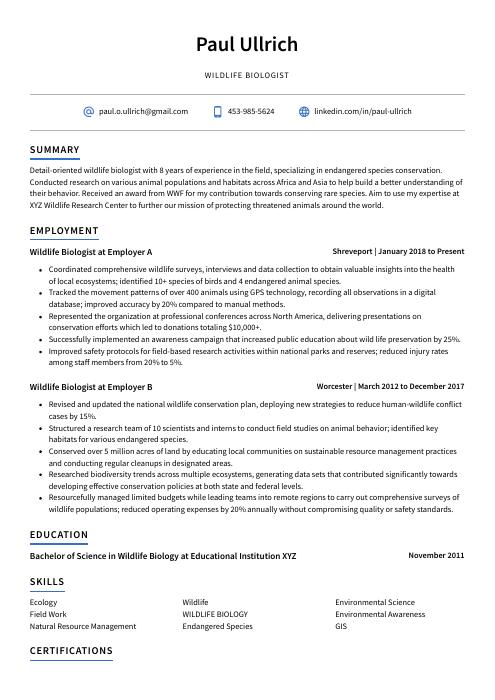 Axolotl
Axolotl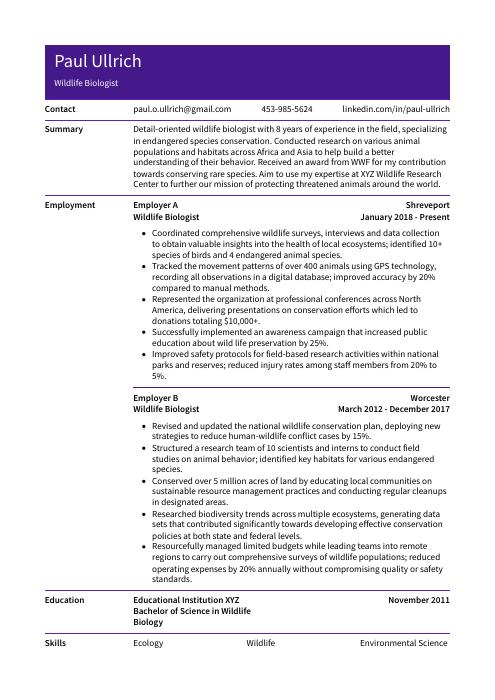 Pika
Pika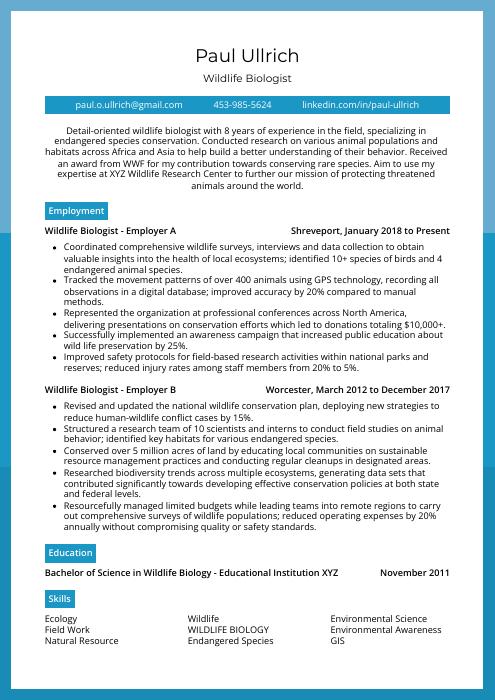 Rhea
Rhea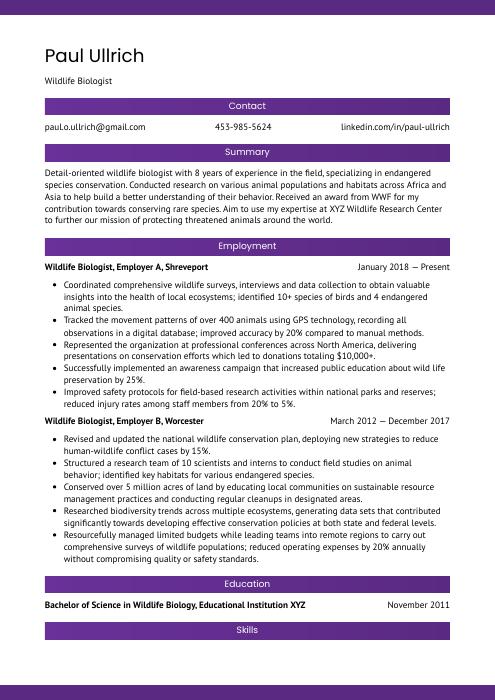 Jerboa
Jerboa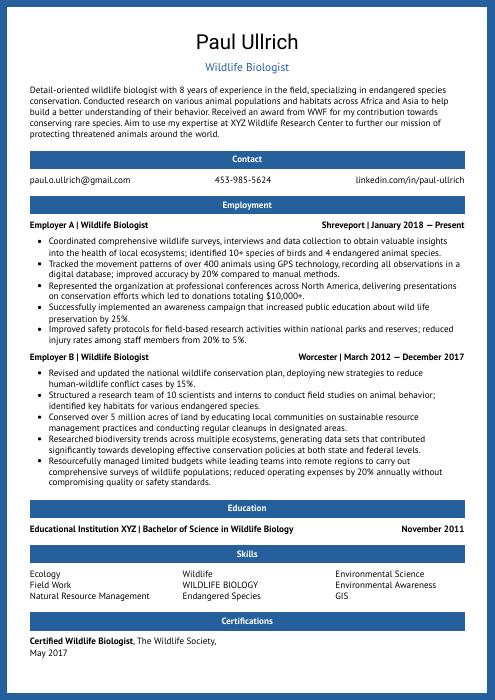 Ocelot
Ocelot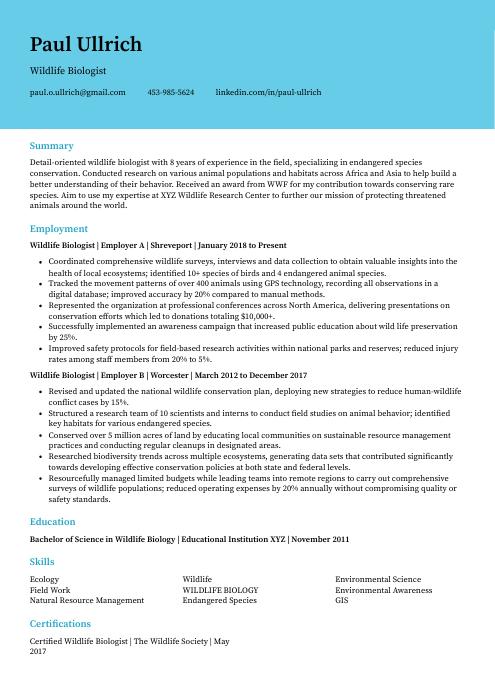 Dugong
Dugong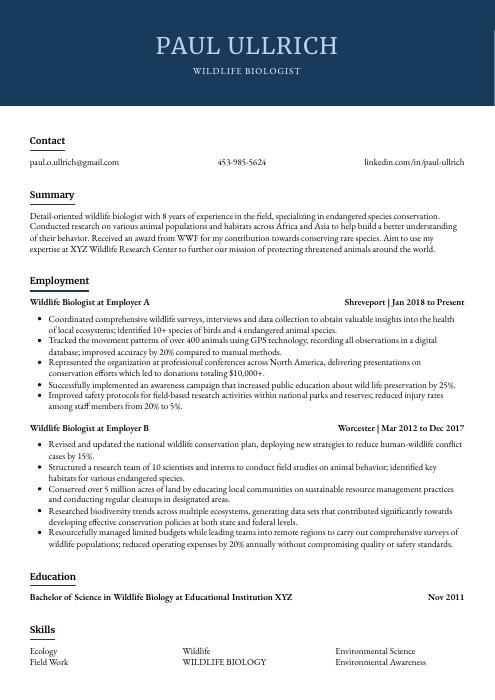 Bonobo
Bonobo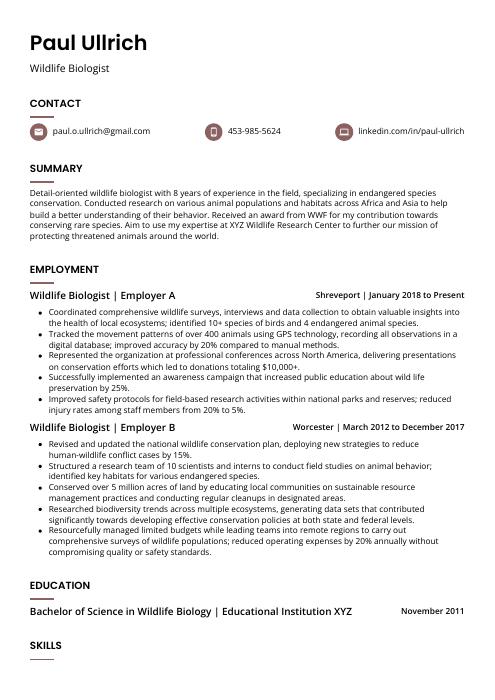 Fossa
Fossa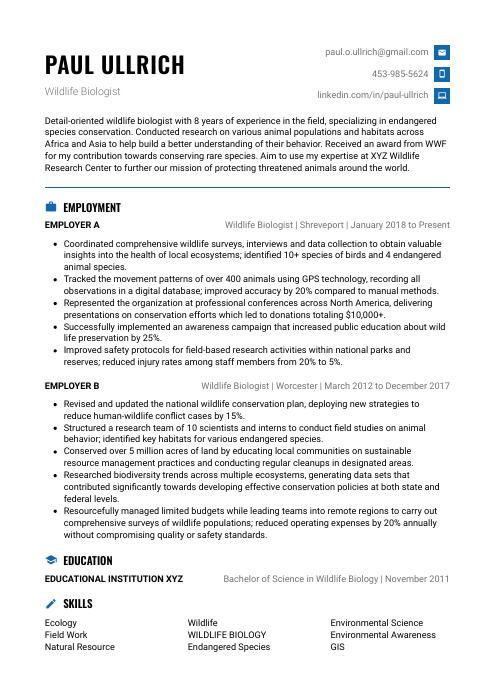 Echidna
Echidna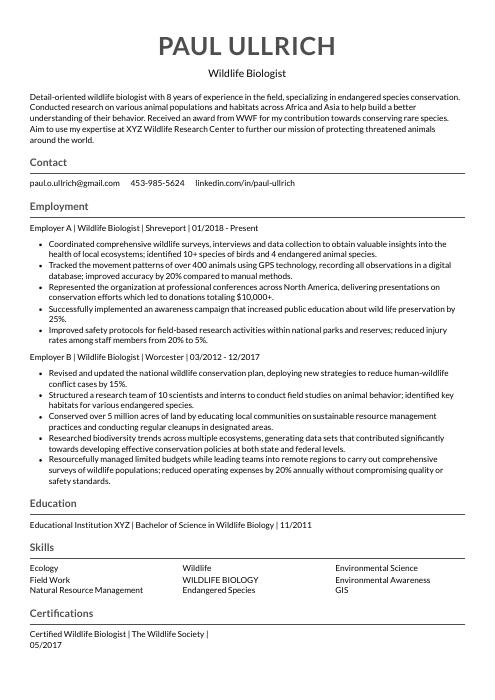 Indri
Indri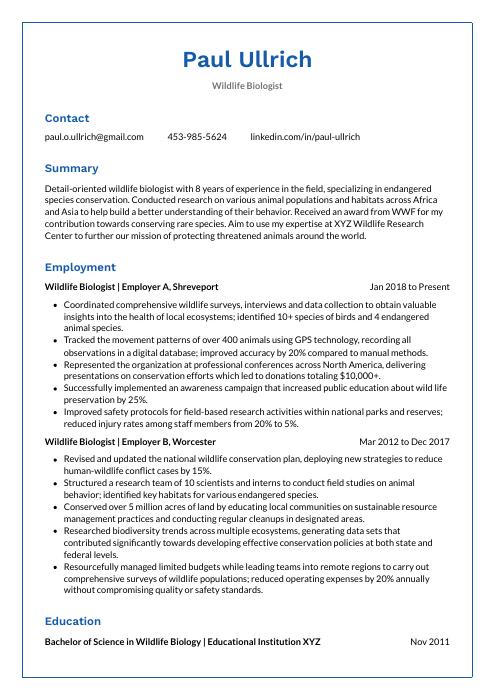 Markhor
Markhor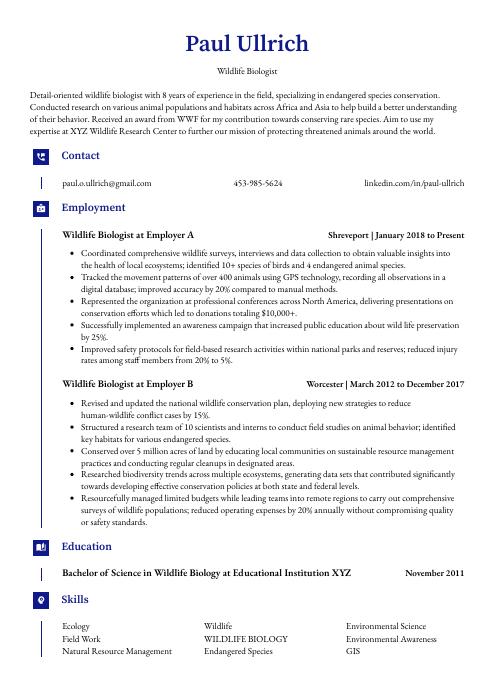 Gharial
Gharial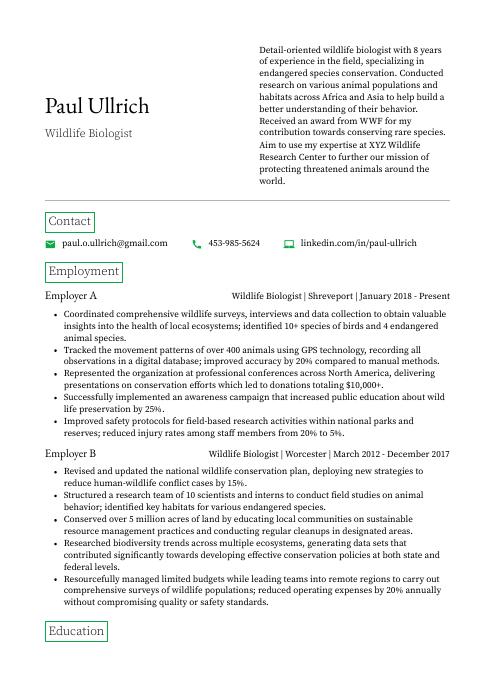 Quokka
Quokka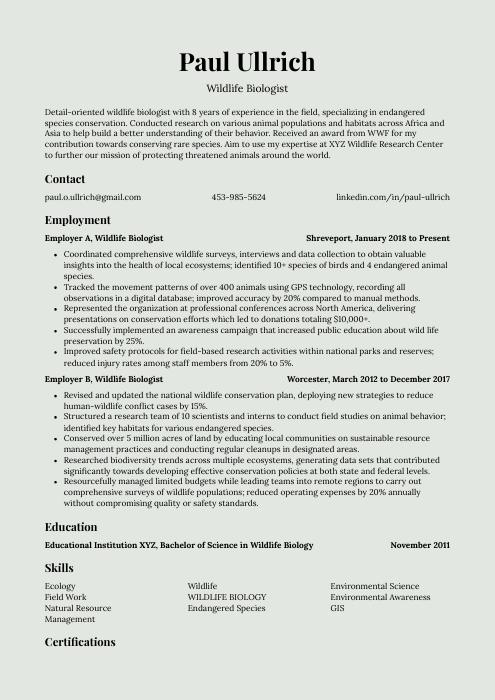 Saola
Saola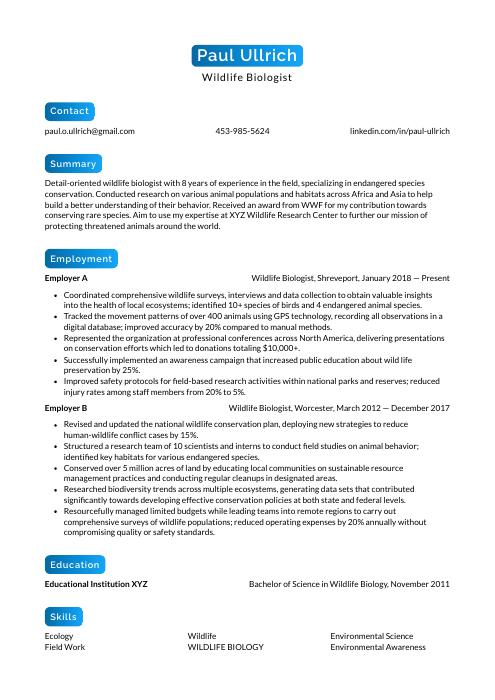 Kinkajou
Kinkajou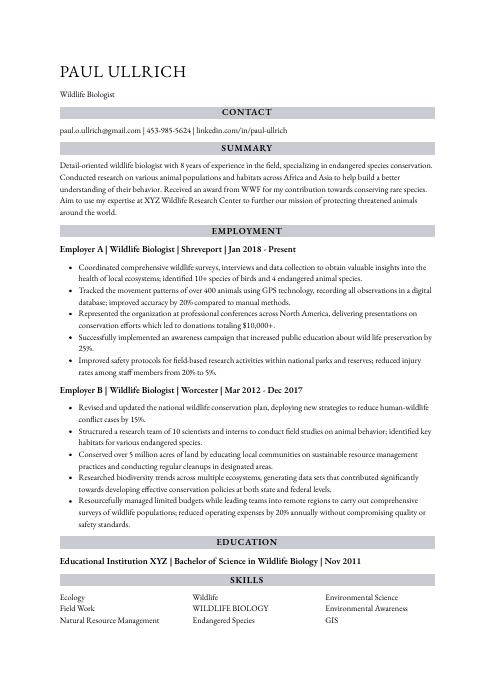 Numbat
Numbat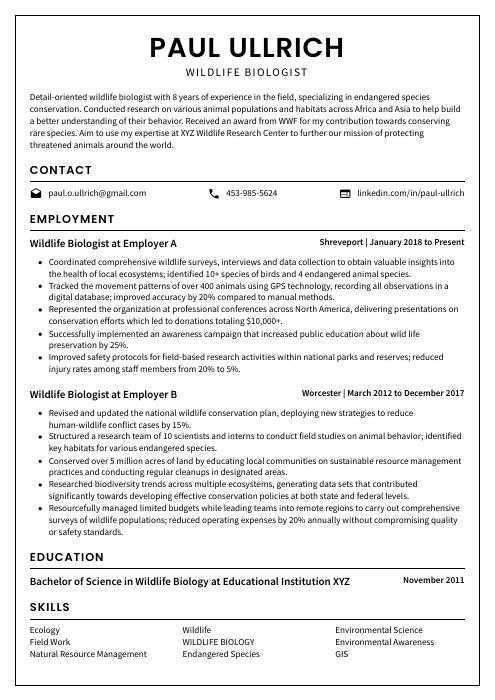 Cormorant
Cormorant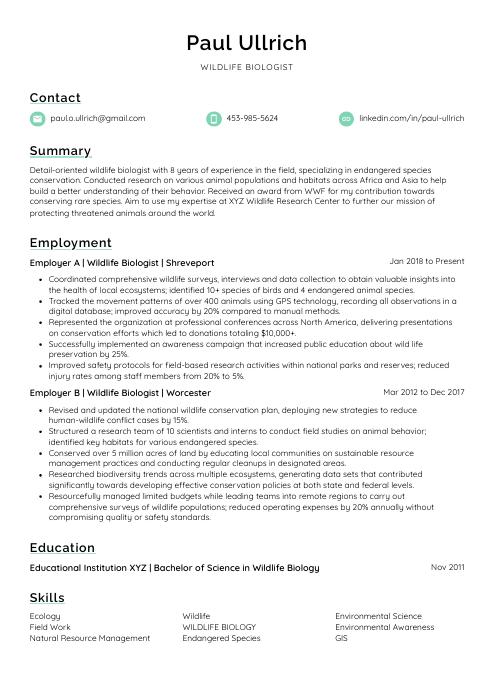 Lorikeet
Lorikeet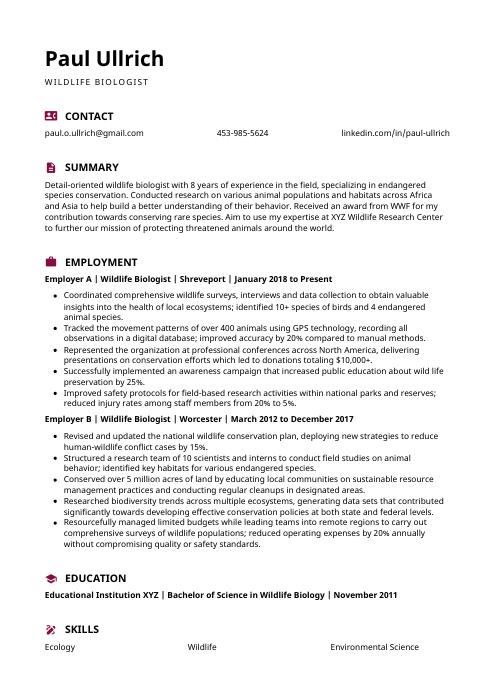 Hoopoe
Hoopoe Rezjumei
Rezjumei
